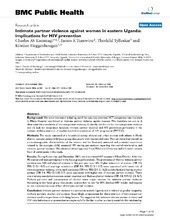Intimate partner violence against women in eastern Uganda: implications for HIV prevention
Journal article
Permanent lenke
https://hdl.handle.net/1956/1959Utgivelsesdato
2006-11-20Metadata
Vis full innførselSamlinger
Originalversjon
https://doi.org/10.1186/1471-2458-6-284Sammendrag
Background: We were interested in finding out if the very low antenatal VCT acceptance rate reported in Mbale Hospital was linked to intimate partner violence against women. We therefore set out to i) determine the prevalence of intimate partner violence, ii) identify risk factors for intimate partner violence and iii) look for association between intimate partner violence and HIV prevention particularly in the context of the prevention of mother-to-child transmission of HIV programme (PMTCT). Methods: The study consisted of a household survey of rural and urban women with infants in Mbale district, complemented with focus group discussions with women and men. Women were interviewed on socio-demographic characteristics of the woman and her husband, antenatal and postnatal experience related to the youngest child, antenatal HIV testing, perceptions regarding the marital relationship, and intimate partner violence. We obtained ethical approval from Makerere University and informed consent from all participants in the study. Results: During November and December 2003, we interviewed 457 women in Mbale District. A further 96 women and men participated in the focus group discussions. The prevalence of lifetime intimate partner violence was 54% and physical violence in the past year was 14%. Higher education of women (OR 0.3, 95% CI 0.1–0.7) and marriage satisfaction (OR 0.3, 95% CI 0.1–0.7) were associated with lower risk of intimate partner violence, while rural residence (OR 4.4, 95% CI 1.2–16.2) and the husband having another partner (OR 2.4, 95% CI 1.02–5.7) were associated with higher risk of intimate partner violence. There was a strong association between sexual coercion and lifetime physical violence (OR 3.8, 95% CI 2.5–5.7). Multiple partners and consumption of alcohol were major reasons for intimate partner violence. According to the focus group discussions, women fear to test for HIV, disclose HIV results, and request to use condoms because of fear of intimate partner violence. Conclusion: Intimate partner violence is common in eastern Uganda and is related to gender inequality, multiple partners, alcohol, and poverty. Accordingly, programmes for the prevention of intimate partner violence need to target these underlying factors. The suggested link between intimate partner violence and HIV risky behaviours or prevention strategies calls for further studies to clearly establish this relationship.
